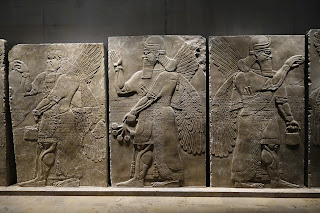Our intended destination was the Staatliches Museum Ägyptischer Kunst. As we headed there from the Hauptbahnhof, Stefan pointed out the sights to E. "See that building over there? That was my Gymnasium [high school]. See the park across the street? We used to throw paper airplanes out the school windows and try to get them to land in the park." So of course, when we walked past the Städtisches Luisengymnasium, E and I nudged Stefan to ring the bell to ask if we could take a quick look around. One of the school's directors gave us a tour. A lot has changed since 1983, but a lot has also stayed the same.
 |
| S, standing in the school's assembly space |
 |
| Glaring corbel ≠ tribble |
 |
| Front entrance of the Luisengymnasium |
Here are one and a half of Inge's doors:
The interior is quite modern now, retaining only few original pillars.
A side chapel contains a beautiful "Black Madonna." Alas, the St. Bonifaz website currently has no information about the church's art, so I have no idea how old this Madonna is.
Ludwig I of Bavaria is entombed at St. Bonifaz, along with his wife, Therese von Sachsen-Hildburghausen.
 |
| Front of St. Bonifaz |
...and the former administrative building of the Nationalsozialistische Deutsche Arbeiterpartei (NSDAP)--the Nazi Party--built for Hitler in the 1930s (along with an adjacent Nazi-style building, the Führerbau). Hanging in front, as of eight days ago, are banners that read...
...Wir (alle) sind das Volk. Designed by Hans Haacke, the banners are part of a travelling exhibit created to honor the 30th anniversary of the fall of the Berlin wall. The slogan refers to a chant used during the Monday demonstrations in Leipzig in 1989-90--wir sind das Volk (we are the people)--but clarifies that "we" means "we all."
Across the street from the Nazi buildings was this fine doorknob:
After a very quick detour to glance at some of the neo-classical architecture in Königsplatz,...
...we finally arrived at the Staatliches Museum Ägyptischer Kunst. On the lawn outside of the museum is a curious sculpture. E thought it looked like it had a bloody nose; Stefan thought it was vomiting blood. Googling that evening, we learned its name is "Present Continuous" (2011) and its nickname is "Barfi." Barfi's red steel pole extends all the way into the Egyptian Museum, which makes me wonder if the sculpture is penetrating the earth with a red-laser eye.
The museum was built in 2013 and is mostly underground. We felt like we were descending into a tomb just entering; the interior staircase from the foyer down to the collection gives a similar impression. The building alone is beautiful in its stony simplicity.
Present Continuous is contemporary art; this sign inside the Egyptian Museum reminds us that all art has been contemporary at some point.
The museum is one of the most elegant and pleasingly informative museums I've ever seen. A bronze rail set into the stone floor guides visitors through the museum, while interactive digital stations provide accessible supplemental information about many of the exhibited pieces.
 |
| Head from a lion-shaped water spout, ca. 1450 BCE |
 |
| Can you see Barfi's laser beam? |
The shard here is from a ~3,800-year-old bread baker, but it looks like it could have been carved yesterday.
The earthenware pot below is far more recent--6th-century CE.
Carly enjoyed these two sculptures of Horus as a falcon, one made of silver (6th-c. BCE) and one of granite (3rd c. BCE):
This display illustrated how a sculptor might turn a block of stone into a detailed, carved figure. I took a picture because I thought it might be instructive for next year's Paschal yam.
More ancient pottery--about 5,000 years old--made with techniques that remain contemporary:
The museum emphasized artistic influences between Egypt and other parts of the world. The last room included these humongous 9th-c. BCE Assyrian genies, formerly painted, with cuneiform text across their middles. Ludwig I bought them in 1863 from their English excavator.
The room also includes a glorious striding lion from the Ishtar Gate of Babylon (ca. 575 BCE). Most of the gate is in the Pergamon Museum in Berlin. (For another Ishtar lion, scroll down to Day 3 of http://wadlstrumpf.blogspot.com/2015/07/berlin-photo-dump-days-2-4.html. Where does this cultural treasure belong?)
...just in time to see the Zugspitze from the back yard as dusk fell.




























No comments:
Post a Comment